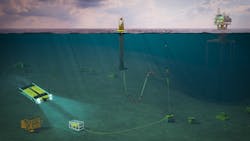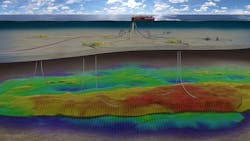Ocean Power Technologies Inc. (OPT), Modus Seabed Intervention, and Saab Seaeye are developing a solution for carbon-free subsea autonomous underwater vehicle (AUV) residency. This system is designed for autonomous offshore operations with the OPT PowerBuoy power and communications platform at its core. Via an integrated mooring and subsea power/data transmission cable, a PowerBuoy can provide carbon-free power to a seabed docking station to recharge an AUV while enabling secure data transmission to and from shore-based operations anywhere in the world.
The autonomous resident AUV system concept has been jointly submitted for US government development and demonstration project funding consideration.
George Kirby, OPT president and CEO, said: “We believe a self-contained system powered by an OPT PowerBuoy and exempt from existing ocean infrastructure has the potential to revolutionize the industrial use of AUVs and make long-term residency a cost-effective reality.
“Modus Seabed Intervention’s experience with advanced technology development efforts in subsea docking with Saab Seaeye’s market-leading hybrid AUV [HAUV] enables autonomous offshore operations and we believe it is a natural fit for our environmentally sound PowerBuoy ocean power and communications technology.”
The ongoing electrification of offshore applications finds underwater vehicles increasingly used for defense and security surveillance, as well as for seafloor mapping and asset maintenance in oil and gas. Increasing the length and variety of missions an AUV can undertake can lower costs and risks, and true autonomous control with access to data in real time is a goal for operators, the company said.
An autonomously powered interactive docking station independent of traditional infrastructure offers efficiency in routine operations and facilitates timely response to ad hoc events (extreme weather, subsea equipment failure) more rapidly than possible with surface-based vessels.
In addition, Eni has extended its lease of OPT’s PB3 PowerBuoy for an additional 18 months.
Following more than one year of continuous maintenance-free operation as part of an AUV charging pilot project offshore Italy in the Adriatic Sea, the leased PB3 PowerBuoy will be redeployed to provide power to systems on an unmanned, decommissioned gas production platform.
The offshore platform conversion project is exploring the potential of future ecologically sustainable life-extension strategies for oil and gas platforms at the end of their productive phase. The project will assess the value of the platform to the ecosystem if left in place, as well as the viability of integrated aquaculture farming, recreational, and other uses.
The system will be relocated off Italy’s Abruzzo region coastline in July 2020.
Deployed in December 2018, the PB3 PowerBuoy has demonstrated its capability as a charging and communications platform to enable the long-term remote operation of Eni’s Clean Sea AUV, the company said. Since being deployed it has produced more than two megawatt hours of electricity.
Barossa subsea contracts awarded
ConocoPhillips has awarded the main outstanding contracts for the subsea infrastructure for the Barossa project off northern Australia. According to partner Santos, these are the last major facilities commitments ahead of a final investment decision, expected in 2Q 2020.
Subsea 7 will transport, install and pre-commission 36 km (22 mi) of in-field flowlines, along with the subsea umbilicals and risers, in water depths of 230-270 m (754-886 ft). The company expects to execute the offshore campaign during 2022-23, using various reel-lay and heavy construction vessels.
Aker Solutions will provide the umbilicals and National Oilwell Varco Denmark the flexible risers.
Barossa will be developed via an FPSO, six subsea production wells, in-field facilities and a gas export pipeline tied into the Bayu-Undan to Darwin pipeline system that supplies gas to Darwin LNG.
Santos holds a 25% interest in the Barossa joint venture along with partners ConocoPhillips (37.5% and operator) and SK E&S (37.5%). Santos is also a joint venture partner in Darwin LNG with an 11.5% interest. Last October, Santos agreed to acquire ConocoPhillips’ Northern Australia and Timor-Leste portfolio including its interests in Darwin LNG, Bayu-Undan and Barossa. •
About the Author
Jessica Stump
Editor
Jessica Stump is editor of Offshore Magazine. She uploads and writes news to the website, assembles surveys and electronic newsletters, and writes and edits articles for the magazine. She was the summer editorial intern at Offshore in 2009 and 2010 before joining full time in April 2011. She has a journalism degree from Texas Tech University.


